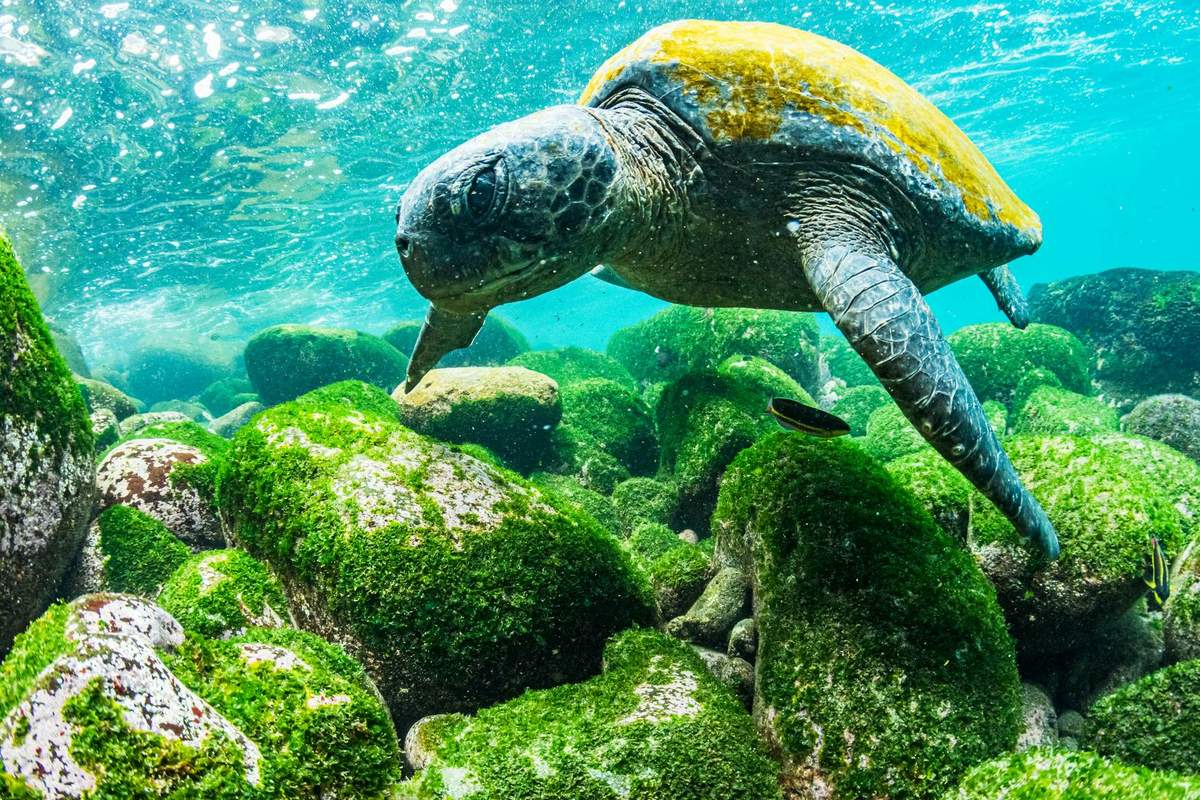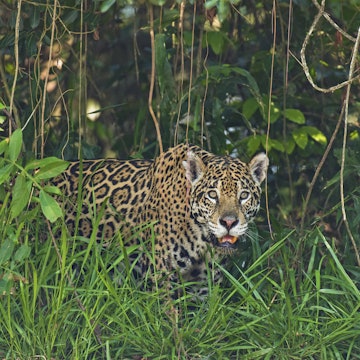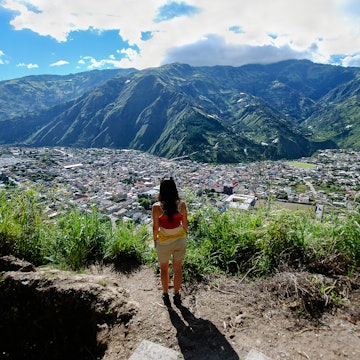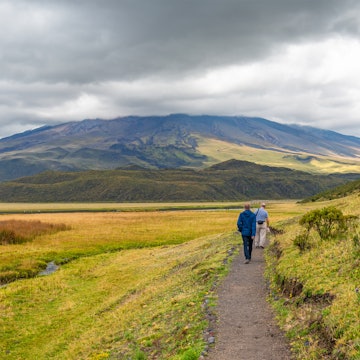

From exploring historic churches to visiting vibrant markets and stunning viewpoints in Ecuador's capital city. jon chica parada/Getty Images
Sitting at the foothills of the Andes, Quito captivates with its 17th-century architecture, indigenous art and cosmopolitan food scene. It could just be the high altitude talking, but for us, the capital city of Ecuador is up there as one of the most breathtaking capitals we’ve seen.
Not only because at 2850m (9350ft), it will literally take your breath away (it’s second only to La Paz as the world’s highest capital), or due to its dramatic location in a valley tucked away in the foothills of the Andes, but also because of its enchanting 17th-century “Old Town” – so immaculately preserved, it was the first city to be granted UNESCO World Heritage status.
Yet Quito doesn’t get the recognition it deserves. Instead, it’s seen mainly as a gateway town for those hellbent on getting to the Galápagos, the Andes and the Amazon. Given the allure of these world-famous attractions, that’s fair enough, but Quito is very much a destination in itself.
With this in mind, here are the 17 best things to do in Quito.
1. Stroll through Quito’s Old Town
As you stroll the cobblestone streets of Centro Histórico (historic center), taking in its treasure trove of magnificent basilicas, grand plazas, elegant palaces, museums and monasteries, it will come as no surprise that it is a UNESCO World Heritage site.
What further impresses is that this is no open-air cultural museum showpiece filled with tacky souvenir stores; instead, it’s very much a pulsating commercial hub without a whiff of a tourist trap. Despite the lavish, heritage backdrop, here it’s very much about the present – the plazas, cafes and restaurants are packed with chatty locals in what remains the capital’s political and cultural beating heart.
2. Make a grand entrance at the Plaza Grande
At the heart of the capital lies the captivating Plaza Grande, the Old Town’s main square, where history, culture, politics and everyday life converge. It’s also known as Plaza de la Independencia, and at its center stands the rousing monument dedicated to the independence heroes of August 10, 1809.
It’s home to some of Quito’s most significant buildings – namely the presidential palace, city hall and Catedral Metropolitana, where quiteños congregate to relax, gossip, discuss politics and protest. The monumental building fronting the plaza from the northwest is the residing place for Ecuador’s president, the Palacio de Gobierno (Carondelet Palace).
Planning tip: Visit the Palacio de Gobierno at noon on a Tuesday for the changing of the guards.

3. Raise your glass at the Plaza de San Francisco
With its mountainous backdrop, the cobblestoned Plaza de San Francisco is one of the Old Town’s most picturesque squares. Hang around for traditional Ecuadorian cuisine at La Bodega de Catuña, built into the stone basement of the nearby church, or peruse the adjacent Ecuador Shops, also within the church’s underground passageways.
Planning tip: While exploring the plaza, make sure to stop at the Iglesia y Convento de San Francisco, a church that dates back to 1535 and is Latin America’s largest religious complex.
4. Light up your night on Calle La Ronda
The romantically lit 17th-century cobblestone Calle La Ronda is Old Town’s pulsing nightlife hub. It’s the go-to place on weekends for its fiesta-vibe of salsa bars, along with live music venues playing everything from ska-jazz to Ecuadorian hip-hop. People spill out onto the streets, with warming cups of canelazo (aguardiente with hot cider and cinnamon).
Detour: About a block north of La Ronda, you’ll find the Museo de la Ciudad. A former hospital dating to 1565 with well-presented exhibits chronicling Quito’s history.

5. Do a pilgrimage to Basílica del Voto Nacional and Iglesia de la Compañía de Jesús
There’s no shortage of grandiose churches in Quito, but none is bigger or more imposing than Basílica del Voto Nacional. This massive, awe-inspiring Catholic church is the largest neo-Gothic basilica in the Americas, and a perpetually unfinished project that legend says if ever completed will mean the end of the world. Instead of gargoyles, you’ll find iguanas, tortoises, caimans, jaguars, dolphins and armadillos protruding from the facade. Its stunning, colorful stained glass is emblazoned with native orchids. The top highlight, however, is the basilica’s towers, from which you can climb to the main roof via steep stairs and ladders for some of Quito’s best views.
For a different slice of Ecuador’s religious history, stop at Iglesia de la Compañía de Jesús, located less than a mile away and gleaming with seven tons of 23-carat gold leaf.
6. Taste some authentic Ecuadorian cuisine at the Mercado Central
Few places offer a more authentic glimpse into local life than a city market, and Quito’s Mercado Central makes a good stop for exactly that. The food is the main highlight here, so bring along an appetite and choose from an array of traditional local options. If you’ve yet to try it, order the encebollado (fish stew), but otherwise, there are corvina (seabass) dishes, fritada (fried chunks of pork, served with hominy) and locro de papas (potato soup served with avocado and cheese).
Planning tip: Be sure to visit the downstairs stalls for local botanicals like coca leaves.
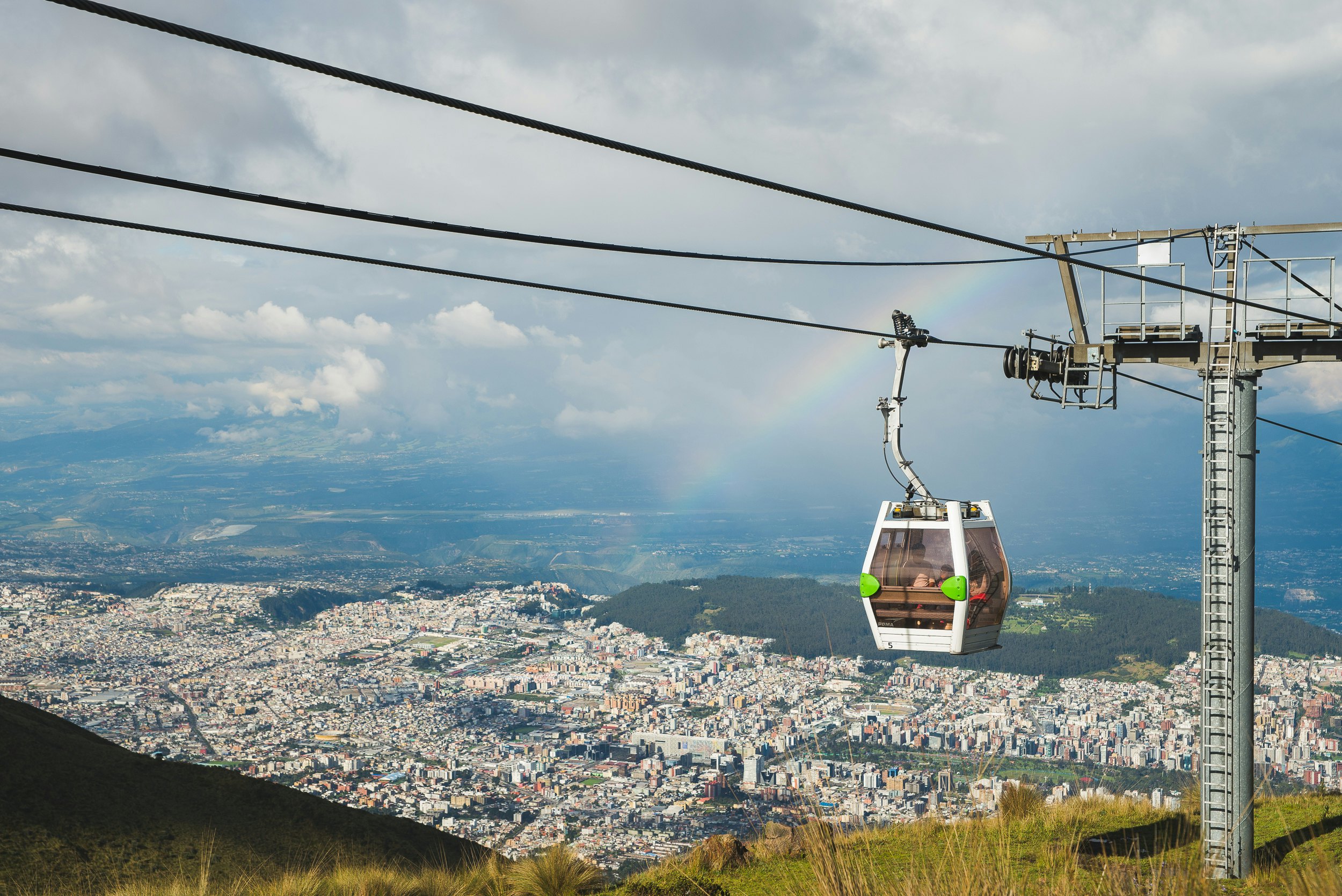
7. Ascend the volcano at TelefériQo
One of Quito’s top attractions is the TelefériQo cable car that climbs just over 2.5km (1.5 miles) along the lower slopes of Volcán Pichincha to the Cruz Loma lookout at 4100m (13,451ft) above sea level. It’s one of the world’s highest aerial lifts, so it’s no surprise it delivers spectacular mountain views; aim for mornings before the clouds roll in. Though most take it for the scenic ride, climbers use it as an access point to ascend the dormant Rucu Pichincha volcano.
Planning tip: If you’re traveling with kids, check out Vulqano Park and enjoy some bumper cars and other rides at the base station.
8. Explore Ecuadorian art and history at Museo Nacional
If you have a keen interest in both indigenous pre-Hispanic culture and 20th-century modern art, then Museo Nacional is one for you. Among its beautifully presented collection of artifacts from Ecuador’s varied cultures and regions are exquisite ceramic sculptures and relics dating as far back as 12,000 BCE. Also represented are some of the country’s finest artists, with original works by mestizo masters Oswaldo Guayasamín and Camilo Egas.
Planning tip: The Museo Nacional is part of the larger Casa de la Cultura Ecuatoriana complex, which also includes the nearby Museo de Instrumentos Musicales (Musical Instruments Museum) and the new Museo Etnográfico (Ethnography Museum).
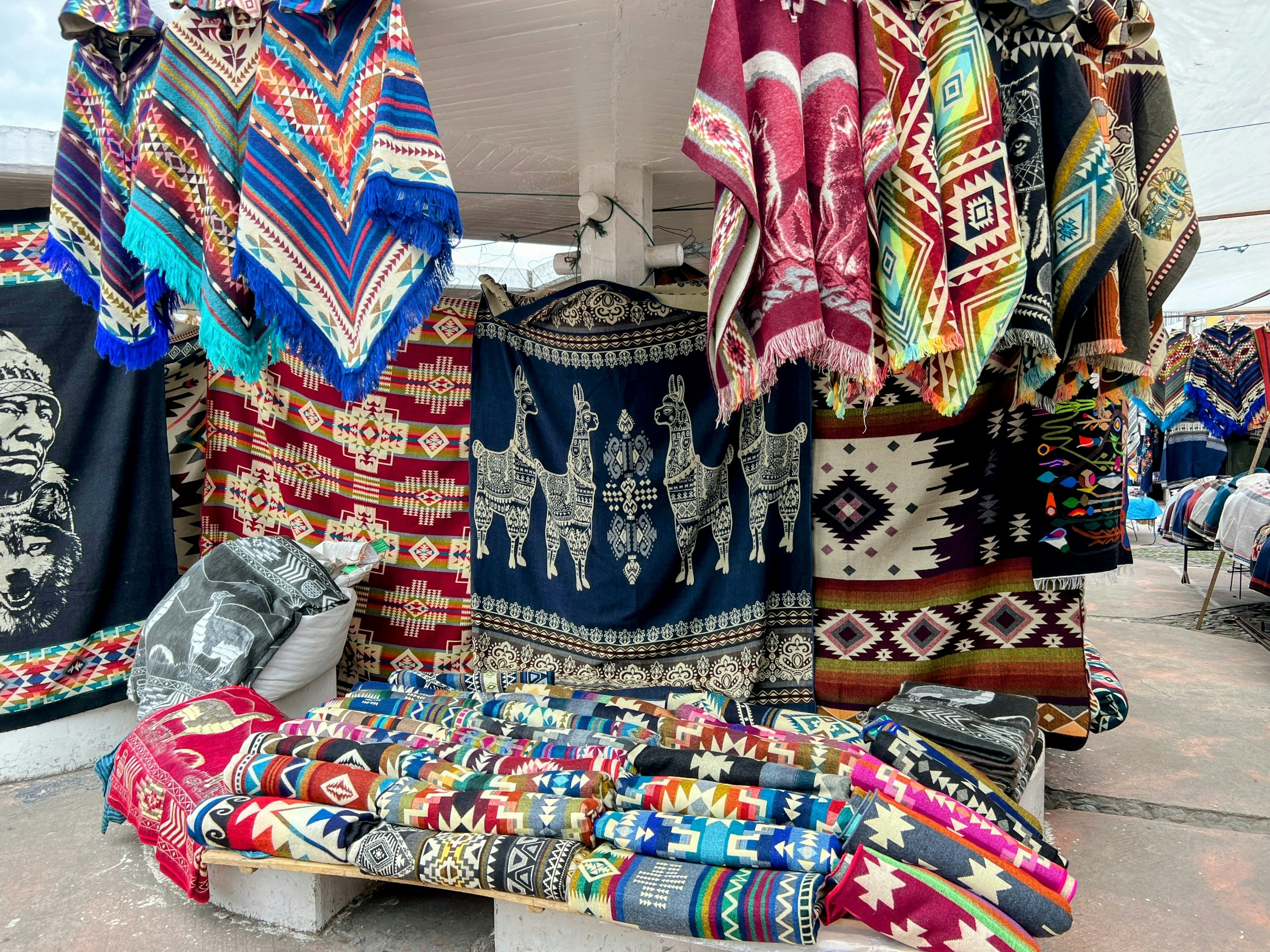
9. Shop around at the Mercado Artesanal La Mariscal
If you can’t make it to Otavalo (Ecuador's biggest market 2 hours north of Quito), then “La Mariscal” is a pretty good alternative, with around 200 stalls selling handicrafts from across Ecuador. If you’re in the market for indigenous-made alpaca-wool blankets, ponchos, Andean music, jewelry and tapestries, this is your one-stop shop for all your souvenir needs.
Detour: Across the way, Galería Artesanal Mitad del Mundo offers a slightly more refined experience with its shopfronts and price tags, while on the other side, Plaza Artesanal Reina Victoria has some less generic offerings with more indie sellers.
10. Fuel up on coffee and chocolate in Mariscal Sucre
Though Mariscal Sucre has etched out a reputation as the place for sordid nights out, by day it takes on a very different persona – it offers a much more relaxed vibe, bringing in travelers primarily for La Mariscal market but also for its cafes. Get your day started at El Cafecito, where they roast their own beans on site, sourced from its farm in Mindo. Set within a converted colonial house, it offers your classic Mariscal vibe. Cacao & Cacao is another highly recommended stop where chocolate is the real hero, and all of it comes from organic cacao grown on the company’s estate.
Detour: A couple blocks north of Mariscal Sucre, the Mindalae – Museo Etnográfico de Artesanía de Ecuador is a great place for those interested in indigenous Ecuadorian culture.
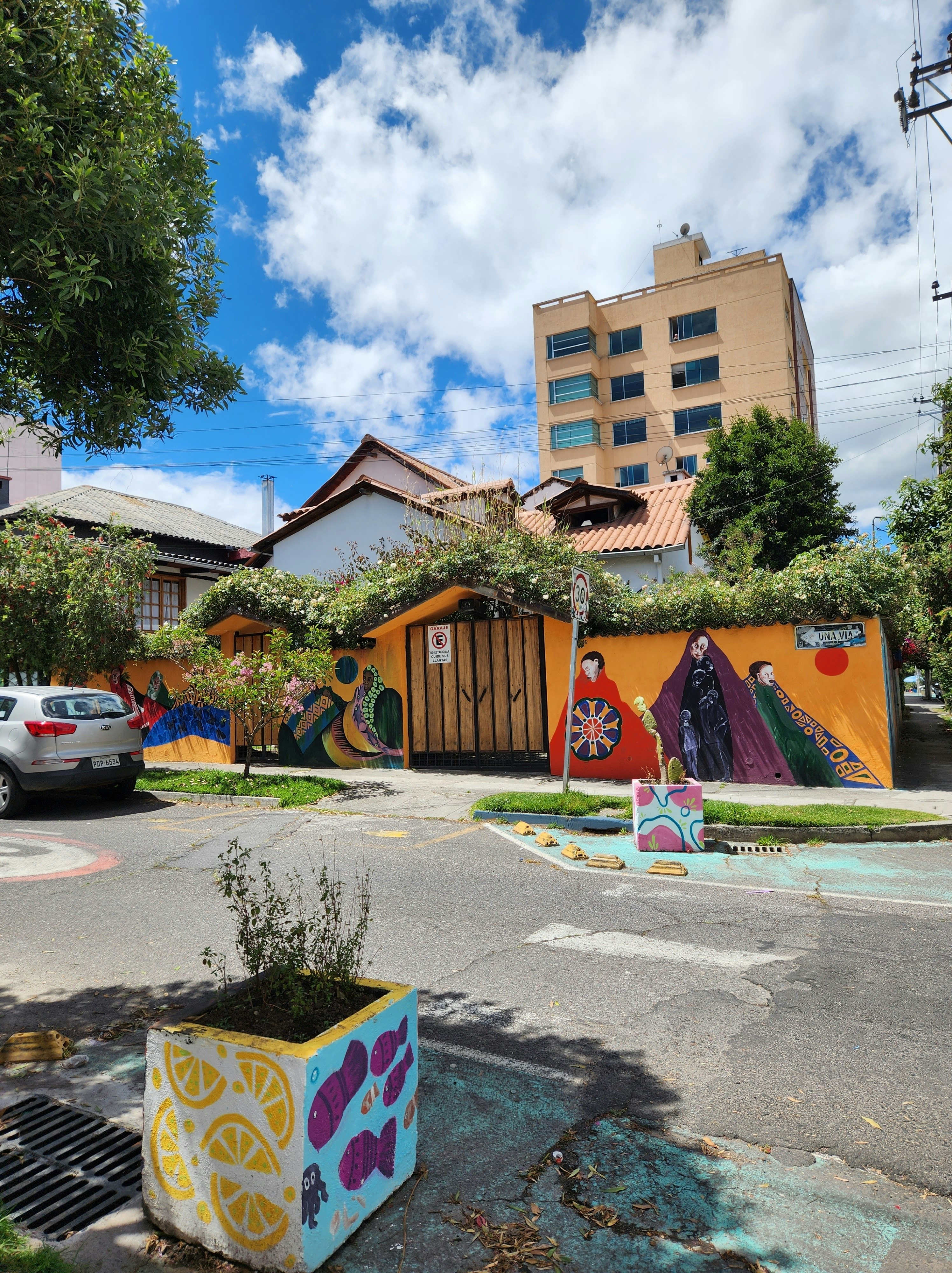
11. Shop local in La Floresta
For those who prefer to get their hit of local culture at cool bars, bespoke boutiques, indie record stores and coffee shops rather than from churches, monasteries and cobblestone plazas, be sure to check out La Floresta. If you have an eye for indie designer boutiques, then shopping could well be the highlight of your La Floresta trip. Here, you’ll find stuff you won’t get at the markets.
If there’s only one store you have time to visit, make it Olga Fisch Folklore. Since 1942, it’s been the place to go for high-quality tapestries, ponchos, crafts, jewelry, bags and accessories. For something more contemporary, La Imaginativa is run by two sisters who stock an eclectic assortment of jewelry, clothing and giftware made by artisan makers from across Ecuador. For ceramics, check out Perro de Loza for the highly regarded work of Natalia Espinosa, who has a workshop onsite to produce her signature cacao coffee mugs among other things.
Planning tip: Other boutiques to look out for are Arte Rayuela, Sphera, and Nudo Street Art Project.
12. Soak up the local coffee culture
Bohemian neighborhoods and coffee culture go hand in hand, so it’s no surprise that La Floresta has some of Quito’s best cafes. One for coffee and design aficionados alike is Roveta, a nano-roaster set within a glassed-in coffee lab that delivers superbly made filtered coffees using local beans roasted onsite. Coati’s is another must-sip venue doing experimental coffees made by a chatty barista who will greet you like an old friend.
Detour: A few blocks north of La Floresta is Fankør Coffee, a Nordic-inspired cafe specializing in single-origin beans.

13. Dine at the hottest restaurants
Led by a new generation of chefs who have embraced ancestral culinary traditions to create innovative, modern Ecuadorian cuisine, La Floresta’s epicurean scene is one no self-respecting foodie will want to miss.
Nuema is a celebration of Ecuador’s biodiversity, with its creative 15-course tasting menus that take you on a seasonal journey through the region’s flavors. Meanwhile, Chez Jérôme offers French-Ecuadorian fine dining where you’ll get anything from duck confit to carrillera de res (beef cheeks braised in red wine and cacao).
You can also try to snag a spot at the 20-seat Quitu, where chef Juan Sebastián Pérez focuses on indigenous-inspired tasting menus. And at URKO, you can feast on chef Daniel Maldonado’s creative Ecuadorian seasonal tasting menus based on indigenous agriculture cycles.
Planning tip: For a more casual bite into La Floresta’s foodie scene, try Parque de las Tripas, a late-afternoon market where you can sample some of Quito’s most traditional cooking.
14. Enjoy a pint of La Floresta’s craft beer scene
Quito might not usually be thought of as a top-tier craft beer destination, but this city actually overflows in fascinating and fun breweries and bars. Sinners Microcervecería is one of Quito’s best, offering award-winning core beers alongside seasonal brews crafted from unique ingredients like quinoa, corn, and cacao. Across the road is Cela GastroCervecería, a welcoming brewpub with good food. And a 10-minute walk will take you to Bandidos Del Paramo and Katari, also worth visiting.
Planning tip: If you need a break from beer, check out the rooftop at La Mezcalería. Or, for the Ecuadorian version of agave-based alcohol, head to hole-in-the-wall Chawar.

15. Take a walk through Parque La Carolina
One of Quito’s best parks to stroll and hang out like a local is the expansive Parque La Carolina in La Carolina, the main district and home to some of the city’s best places to eat. On the weekends, it’s packed with families and couples here for its street food stalls, paddle boats, picnics and soccer. During the week, it’s a much more relaxed affair, making it a good time to appreciate the wonderful bonsai collection at Jardín Botánico without the crowds.
Detour: Next door is the Museo de Ciencias Naturales, an interesting natural history museum showcasing an impressive collection of taxidermied Ecuadorian species.
16. Visit the slightly-off-mark equator line at La Mitad del Mundo
The equator’s centerpiece attraction is La Mitad del Mundo, built in the late 1970s to commemorate where the 18th-century Spanish-French Geodesic Mission arrived to mark the “middle of the world”. Somewhat awkwardly, it was later discovered it was about 200m (656ft) off. Despite the error, crowds flock for photos and to scale its 30m (98ft)-high, stone trapezoidal monument. It’s topped by a brass globe containing a viewing platform and a museum highlighting Ecuador’s ethnic groups.
Planning tip: The sprawling site has a bit of a tacky theme-park feel to it. Among the restaurants and a microbrewery are various small museums dedicated to anything from beer to chocolate.
17. Stand on the real equator at Museo Solar Inti Ñan
A short stroll from La Mitad del Mundo, this quirky equator museum prides itself on being the real location of the equator. Guided tours take you to a 19th-century “solar chronometer”, which shows precise astronomical and conventional time and the month, day and season – all by using rays of the sun.
But the main attractions are its weird and wacky scientific experiments demonstrating the natural phenomenon that is latitude zero. Like an illusionist magic show, they will leave you as intrigued as dubious.
This article is adapted from Lonely Planet’s Ecuador & the Galápagos Islands guidebook, published in June 2024.






